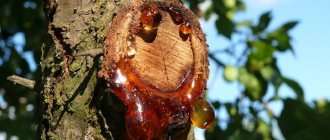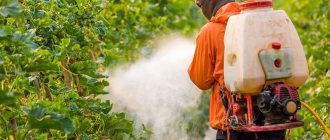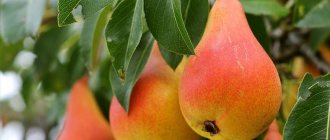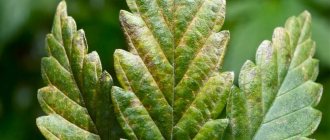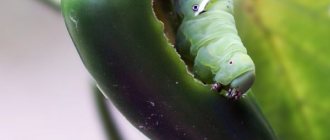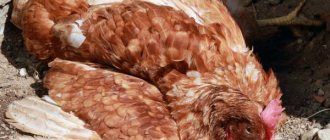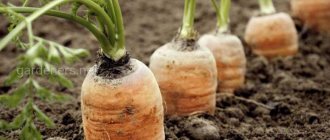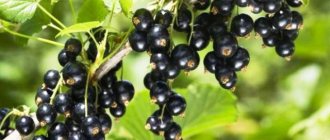When growing cucumbers, gardeners often encounter a wide variety of plant diseases. One of the most dangerous is peronosporosis. If cucumbers are not treated, the foliage of the affected plant dries out, after which it dies.
Diseased cucumber bushes are a depressing sight. The gardener thinks not only about the loss of the harvest, but also about the contamination of neighboring plants and related crops. How to help cucumbers with peronosporosis and what to do to prevent the disease in the future, we will tell you in this article.
What is peronosporosis
Downy mildew of cucumbers (downy mildew) is a fungal disease caused by lower fungi, oomycetes.
Cucumbers, like other plants of the pumpkin family, are attacked by Pseudoperonospora cubensis.
Pathogenic spores persist on plant debris and in the soil. In spring they are carried by wind and raindrops.
Penetration and infection are facilitated by mechanical damage to plants.
Downy mildew is found everywhere: cucumbers can get it both in open and closed ground, that is, in greenhouses and greenhouses.
Why are cucumbers dangerous?
The harm of peronosporosis lies in damage to the leaf apparatus of the vegetable. The tops turn yellow and die, and photosynthesis processes are disrupted. Plants may die within a week.
Even if the infected bush blooms and bears fruit, their quality and quantity will be extremely low. Losses due to disease account for 30-100% of the crop.
Remedies for downy mildew (preparations)
For peronosporosis, both folk remedies and chemicals, or more precisely, fungicides, are used. The following pesticides are most popular among gardeners and gardeners:
- Acrobat MC . This is a drug of contact and systemic-local action, which is very toxic to humans.
- Alirin-B . This biological agent suppresses fungal diseases both in the soil and on plants. Its action is very similar to Fitosporin-M.
- Bordeaux liquid . A broad-spectrum contact drug, very toxic to humans.
- Gamair . It is a biological bactericide that is used to control bacterial and fungal diseases both on crops and in the soil.
- Glyocladin . This biological drug actively fights fungal pathogens. It is an analogue of Trichodermin.
- Oksikhom . A systemic contact drug with a wide spectrum of action and is highly toxic to humans.
- Polycarbacin . This is a systemic drug with therapeutic and prophylactic action. It is used for processing vegetable and fruit crops.
- Bravo . Contact protective agent. Its duration of action is from 1.5 to 2 weeks.
- Previkur . The systemic drug has a wide spectrum of action and is used in the fight against downy mildew and root rot.
- Ordan . This contact-systemic drug is moderately dangerous for humans.
- Ridomil Gold . Contact system means. Very toxic to humans.
- Trichodermin . This biological remedy is used to protect and treat root diseases. It is used to treat both indoor and ornamental plants.
- Fitosporin-M . A contact microbiological preparation that is used to protect crops from various fungal diseases.
- Quadris . Systemic drug with protective and therapeutic effects. It has one unusual property - prolonging the fruiting of plants by 15–20 days.
- Revus TOP . This remedy is used both for the treatment and prevention of fungal diseases.
Symptoms of the lesion
Downy mildew is diagnosed by several characteristic features. Our photos will help you identify the disease.
External signs
Yellow angular spots appear along the veins on the upper side of the leaf. Over time, the lesions acquire a brown tint. The edges of the leaves turn upward.
After 1-2 days, a grayish or whitish coating appears on the back side of the leaf blade.
Infected plants are stunted in growth, stems and root systems weaken. The affected tissues have a faded, limp appearance.
Stages of development
Downy mildew develops rapidly. The incubation period at a temperature of 18ºC and 100% relative humidity is three days.
The disease occurs in several stages, which quickly replace each other:
- At the initial stage, yellow spots appear.
- The affected areas become oily. On the reverse side of the leaf, spore-bearing organs sprout - areas of grayish or white coating, velvety in appearance.
- The spots turn brown and increase in size.
- The foci of infection merge. The leaf dries out and falls off.
- The final stage is characterized by large-scale death of the leaf apparatus and death of the plant.
Risk factors
A decrease in air temperature to 15-20 º C and rainy weather increase the risk of infection. Planting cucumbers in shaded and poorly ventilated areas contributes to the development of the disease.
Too dense plantings, insufficient insolation, and relative humidity above 80% are risk factors for greenhouse vegetables.
Downy mildew on shrubs
Grapes are also affected by downy mildew, but in this case it is called mildew. For European grape varieties, this disease poses a very great danger. Mildew was brought to southern France in 1878 from North America. If the affected grapes are not treated, the damage to the vineyard can be significant.
The disease affects the upper parts of stems, foliage, tendrils, inflorescences, young fruits and ridges. To preserve grapes, you will need to carry out preventive treatments of the bushes in a timely manner; for this, products such as Cabrio TOP, Polyram, Acrobat TOP or Delan are used. The bushes are treated before flowering, and then during rains, heavy and frequent dew, and at high humidity, spraying is carried out once every 7 days. If the weather is dry, then treatments are carried out once every 15–20 days. Throughout the season, grapes are sprayed 2–8 times for preventive purposes.
Treatment of cucumbers
Oomycetes are not easy to eradicate. It is unlikely that it will be possible to completely save the crop, but it is possible to help the plants.
Destruction of affected areas
When a small number of leaves are affected, they should be removed without regret and destroyed outside the site. This will help prevent the spread of infection.
However, one cannot limit oneself to such a measure.
Agrotechnical techniques
Agrotechnical control measures include:
- Regular weeding and removal of plant debris. This technique promotes better ventilation of plants.
- Timely and reasonable feeding. Gardeners note that the degree of infection increases with a lack of potassium and phosphorus, as well as with an excess of nitrogen.
- Ventilation of greenhouses and removal of overgrown shoots.
Biological agents
Fungicides of biological origin are recommended for use in the initial stages of the disease or for prevention. As an example, here are a couple of drugs:
- "Trichodermin." Contains live spores of the fungus Trichoderma sp. When they germinate, they release antibiotics and substances that have an antifungal effect. The drug is available in the form of a powder or aqueous suspension. To spray plants, prepare a working solution from 20-40 ml of liquid or 20-40 g of powder and 5 liters of water. Consumption - 5 liters per 1 hundred square meters.” Trichodermin" is used at a temperature not lower than 18 º C, otherwise beneficial spores are not activated. Safe for bees. May cause allergic reactions upon contact.
- "Planriz." Created based on living soil bacteria Pseudomonas fluorescens, which produce natural fungicides. The product is produced in the form of a liquid in bottles of various sizes. To prepare the working fluid, take 10 ml of the mother solution per 10 liters of water. Root spraying is carried out at the rate of 0.5-1 liters per 1 m². Safe for humans and insects. The shelf life of the drug is limited to three months.
Important! Biological products are incompatible with any pesticides. They should be used no earlier than two weeks after the last chemical treatment.
Chemicals
If time is lost and the infection has spread throughout the cucumber bed, only chemicals will help
The following drugs are suitable for the treatment of peronosporosis:
- Previkur Energy. The active ingredients are propamocarb hydrochloride and aluminum fosetyl. The drug has a narrowly targeted effect and destroys exclusively oomycetes, which include the causative agents of peronosporosis. 25 ml of the product are diluted in 10 liters of water and watered at the root, avoiding contact with the leaves. The consumption of the working solution is approximately 10 liters per 1 hundred square meters. A maximum of three treatments are carried out with an interval of 10-14 days.
- "Kuprolux". A preparation based on cymoxanil and copper oxychloride of contact-systemic action. Low danger to bees and humans. Available in the form of a wettable powder. For spraying, prepare a solution of 25-30 g of the substance and 10 liters of water. Treatment is carried out no more than three times per season with a break of 10-12 days.
- Copper oxychloride (“CHOM”) is an inexpensive drug with protective contact action, recommended for use as a prophylactic agent. The frequency of treatments is three times per season with an interval of about two weeks. Liquid for treating plants is prepared from 40 g of the substance per 10 liters of water. Spraying is carried out at the rate of 1 liter per 10 m². Poses moderate danger to humans.
Important! To preserve the effect of chemicals, you need to carefully treat the underside of the sheet.
Traditional methods
Traditional methods are safer, but not as effective as pesticides. Most often they are used as preventative measures or at the very beginning of the disease.
Experienced gardeners advise trying several recipes:
- Soda. Dissolve 40 g of baking soda in 5 liters of boiled water, add 15 ml of liquid soap. Spray the bushes and soil with the resulting mixture once a week.
- Onion peel. Pour 500 g of onion peel into 10 liters of water and boil. Leave to infuse in a dark place for 1-2 days. Strain the infusion and spray the cucumbers several times a month.
- Potassium permanganate. Spray the plants with a weak solution of potassium permanganate (1-1.5 g per 10 liters of water) once a week.
- Milk serum. Add 30 drops of pharmaceutical iodine and 30 g of grated laundry soap to 1 liter of whey. Spray the bushes as a preventative measure once every 10 days.
Description of the disease
The causative agent of peronosporosis is a pseudofungus, or mycoid Pseudoperonospora cubensis Rostowz, from the genus Pseudoperonospora, class Oomycetes.
The microorganism is able to exist and develop only by parasitizing the tissues and organs of the host. It affects only pumpkin plants: cucumbers, zucchini, watermelons, melons, pumpkin, squash. Leaves are attacked by the pseudofungus, and less often, ovaries and flowers.
The fruiting bodies of the microorganism formed on the leaves of cucumbers produce oospores in early autumn. They end up in the ground, where they are able to overwinter even in fairly severe frosts. In spring, when the temperature rises to 12-18°C, oospores turn into zoospores. They are small, single-celled organisms with two flagella that can swim in water. That is why the disease most often develops at high air and soil humidity, in rainy summers.
When a drop of water falls on the lower part of a cucumber leaf, the zoospore penetrates the stomata (plant organs that perform the role of gas exchange). Peronospora forms mycelium inside the leaves. Mycelium hyphae grow in the intercellular space, and its lateral processes penetrate into the cells. The false fungus literally sucks out the cucumber, taking water and nutrients from the cells.
The overgrown mycelium comes out and can be seen on the bottom of the leaf in the form of a fluffy coating with black dots. This plaque contains millions of oospores.
The pathogen is transmitted by the wind and parasitic insects. As it develops, new leaves are constantly affected. If there is a lot of rain in the summer, up to 15 generations of pseudofungus can develop on one plant.
Features of treatment in a greenhouse and open ground
The principles of treatment of peronosporosis are common for indoor and open ground.
The difference is that it is easier to regulate the microclimate in a greenhouse. To reduce humidity, ventilation is carried out more often. Bricks or stones are used to maintain temperature. They warm up during the day and give off heat at night. Water containers work on the same principle.
Special care should be taken when using chemicals in a greenhouse. After treatment, it is recommended not to enter the room for a day.
Conditions for the occurrence of the disease
In dry, hot weather (from +27℃) the disease caused by pseudofungi does not develop. Infection occurs under unfavorable weather conditions: moderately warm weather during the day (+18 - 20℃) and lower temperatures at night; increased (80 – 100%) air humidity; prolonged precipitation, fog. Inappropriate conditions for growing cucumbers also lead to the intensive development of peronosporosis:
- thickening of plantings;
- water getting on the leaves of the plant;
- watering with cold water;
- waterlogging of the soil;
- contamination of beds with weeds.
In open ground, the disease is also caused by heavy dew, in a greenhouse - by poor ventilation. Peronosporosis is sometimes accompanied by bacterial infections - root rot, bacteriosis.
Preventive measures
Prevention of downy mildew is simple. A number of measures will help protect plants:
- In the fall, be sure to remove all plant residues from the beds and burn them.
- Cucumbers are not planted in the same place year after year.
- Before planting, treat the seeds in a 0.1% solution of potassium permanganate for 30 minutes.
- They follow the rules of agricultural technology: they regularly weed the beds and apply fertilizers in accordance with the needs of the plants.
- To increase the immunity of vegetables, stimulating drugs are used: potassium humate, Gumistar, Baikal EM-1.
- Water the cucumbers only with warm, settled water.
Prevention
To prevent downy mildew, follow the rules of crop rotation. A cucumber bed cannot be made in one area several times in a row. It is not advisable to plant this crop after squash, zucchini, and pumpkin. At least three years must pass between planting these crops in one place. Ideal predecessors for cucumbers would be carrots, garlic or onions.
When growing cucumbers in greenhouse conditions, the inner walls of the shelter and soil after harvesting in the fall and before planting seedlings in the spring are treated with disinfection preparations. The bushes are planted at a distance from each other so that they are well lit and provided with air.
In the fall, cucumber beds are cleared of weeds and tops. The remains of infected plants are burned. The soil is dug up deeply. Additionally, the soil is spilled with a disinfectant solution. To do this, you can use a 1% solution of potassium permanganate or copper sulfate with a concentration of 2%. The disinfectant will destroy oospores and other pathogens. Greenhouse soil is treated especially carefully.
Resistant varieties and hybrids
Planting plants that are resistant to it will help reduce the risk of downy mildew. There are no cucumber varieties and hybrids with complete resistance to this disease. However, many of them have sufficient immunity.
Thus, during an epidemic of downy mildew, within 12-18 days from the beginning of fruiting, hybrids such as:
- Artek f1;
- Doubler f1;
- Baby crane f1;
- Swallow f1;
- Octopus f1;
- Eaglet f1;
- Semcross f1;
- Swift f1;
- variety Chizhik and others.
The following varieties have the maximum possible ability to bear fruit within 21-28 days with a strong spread of the disease:
- Far Eastern 27;
- Moment;
- Phoenix;
- Phoenix plus.
Varieties with complex resistance to fungal pathogens include:
- Little Cupid;
- Erofey;
- Cascade;
- Whale;
- Lotus;
- Swag.
Hybrids have also been bred that have no doubt about their resistance to downy mildew:
- Brunette f1;
- Debut f1;
- Katyusha f1;
- Beauty f1;
- Sturdy f1;
- Frant f1.
The causative agent of infection
The appearance of the disease is provoked by fungi of the genus Peronospora - lower species from the Peronosporaceae family. Pseudofungi parasitize on plant leaves in summer; in winter they live in organic debris in the form of dormant oomycete spores. When the air warms up to + 10 – 13℃, zoospores are activated and begin to germinate. Microorganisms move quickly in a humid environment and create mycelium in the tissues of the cucumber.
We recommend reading: Diseases of cucumbers.
During the summer season, the infectious agent generates at least 15 generations of new mushrooms. The spores, which intensively capture healthy plants, remain in the soil for six years. Spread by precipitation and air currents. Transmitted through contaminated seeds and soil. The source of infection is increased by insect pests (aphids, whiteflies, ants).
Note! Moisture is necessary for the spread of peronosporosis pseudofungi. The pathogen does not affect dry organic tissues.
Photo
